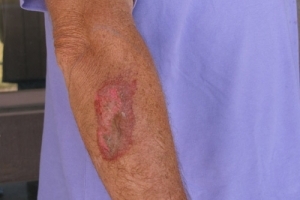
There are many causes of burns on farms. These include burns from friction, heat, sun, chemicals, equipment and fuels.
Some causes of burns include UV radiation (sunburn), flame, radiant heat, hot liquids or gases, electricity, fuels and certain chemicals. The cause of the burn will determine the category of the burn. Sometimes farmers use burning to reduce pests in fields, get rid of stubble and snails. Carelessness is the most common cause and to avoid burns on the farm and in the home, proper safety precautions needs to be undertaken.
There are several categories of burns
- Dry/wet burns – flames & scalds
- Chemical burns – e.g. acid, alkaline (lime), or organic compounds
- Electrical burns
- Mouth/throat/inhalation burns
- Radiation burns
- Molten substances/plastics/metals and bitumen burns
All deep burns need emergency medical care and the management of the burn will vary depending on the category of the burn.
General management involves: Ensure you are no longer in contact with the source of the burn. Applying cool running water over the burn site for 20 minutes, or until the skin has cooled. Do not break blisters as these provide a sterile cover for the burn, do not apply ointments or oils. Cover the area with a sterile/ clean non fluffy dressing. Arrange urgent medical assistance.
Major burns are a medical emergency and require urgent medical attention. Do not remove burned clothing if it stuck to the burned area, rather cool it by continuously pouring water on it. In some cases, skin graft surgery is needed.
Always call triple zero Tel 000 for major burns. You will be given advice over the phone on how to manage the burn.
For more information on (Burns and Scalds) visit Better Health Channel
Immediate Burn Treatment – video
Fast facts:
- Major burns are a medical emergency, minor burns can be managed at home.
- Burns can be caused by sun exposure, fire, hot liquids, chemicals, electricity and lightning.
- Apply cool running water over the burn site for 20 minutes or until the skin has cooled.
- Call triple zero (000) for an ambulance immediately if someone experiences a major burn.
References used for this topic
More information:
Victorian Adult Burns Service – First Aid,
First Aid
Patient information sheets
Better Health Channel
Burns and scalds in children
St John
Burns
Raising Children
Burns and scalds first aid
Better Health Channel
Eyes – Flash Burns
Clinical care:
Royal Children’s Hospital Melbourne
Burns
Research & reviews:
Journal of Multidisciplinary Healthcare
Occupational chemical burns: a 2 year experience in the ED
American Academy of Pediatrics
Preventing unintentional scalds and burns: moving beyond tap water [PDF 300kb]
Cochrane Collaboration
Dressings for superficial and partial thickness burns (Review) [PDF 540kb]
World Health Organization (WHO)
Burns
|
|